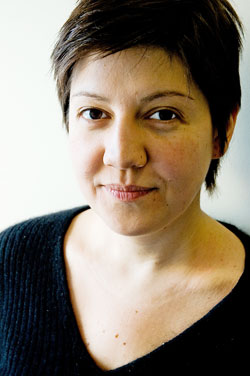Historian listens to early radio audiences

Elena Razlogova has been granted SSHRC funding to pursue her interest in digital history.
Rob Maguire
Elena Razlogova knows the importance of audience. The relationship between message producers and recipients has become the focus of her research.
“It’s the notion of reciprocity,” Razlogova said.
Razlogova was interested in studying audience reactions to early cinema while a cultural studies student at George Mason University, in Virginia. “I am interested in the role of audiences in making popular culture.”
However she soon realized that although the early years of cinema as both a technology and an urban phenomenon were well documented, there was very little information about those who were watching the movies, and their reactions.
Instead, she discovered a number of unlikely sources for information about radio audiences which led to her dissertation and, ultimately, her book from Pennsylvania Press, The Voice of the Listener: Americans and the Radio Industry, 1920-1950, due out next year.
She found letters by the boxload from listeners in network archives, in files from old soap operas and among the papers of early broadcast personalities like newscaster Eric Sevareid. This material yielded a wealth of information.
Most broadcast researchers have assumed that radio moved easily from an amateur hobby to a commercial system. Razlogova discovered that the relationship between broadcasters and audience was dialogic. “Listeners’ concerns were considered by writers, and media producers responded to their audience.”
In fact, the letters suggest that many listeners had strong opinions about who owned the airwaves. “When radio was developed enthusiasts built receivers, communicated directly with each other, and shared technology.” Commercialization changed all of that.
Razlogova sees direct parallels between that early momentum and the current open source software movement. Her curiosity about audience participation in a historical context explains her current interest in the digital archiving of old documents and images. Digital repositories ensure a wide audience for a broad range of materials, some of which might be too fragile for regular manipulation.
At Concordia, she is active in the Centre for Oral History and Digital Storytelling. She has been involved helping the library digitize their South African collection.
She intends to make some of her upcoming book available on the web. “Books reach an audience of students but the web has the potential to reach much larger audiences.”
She continues to work with the Centre for History and New Media at her alma mater.
She has just been awarded a $44,000 grant from SSHRC to further explore the potential of digital history. “Making research open source” is a joint project between George Mason University and representatives of three departments at Concordia, with Razlogova as principal researcher.
On a recent trip home to Russia, she travelled to Perm, in the Ural Mountains. Using the help of a local film crew, she captured digital images of a gulag camp there.
The camp had been built during Stalin’s time in power during the 1930s. Ironically, it was used in the ’50s to imprison Stalin’s former secret police. These high-level bureaucrats were granted more luxury and perks than most prisoners. The result, according to Razlogova, was a jarring juxtaposition of harsh cells nestled within an orchard planted by the privileged prisoners. This camp was eventually shut in the 1980s.